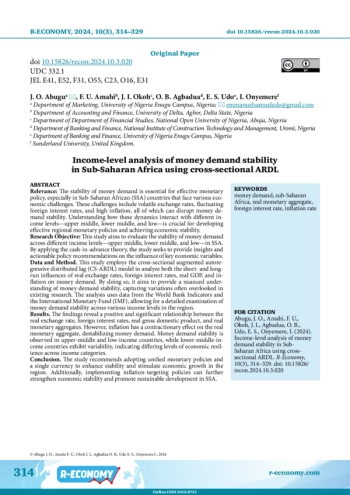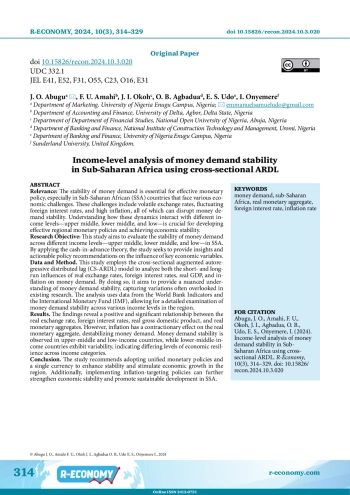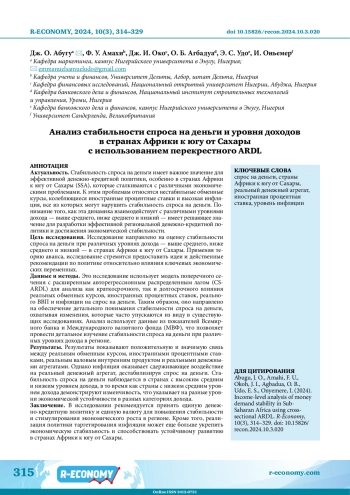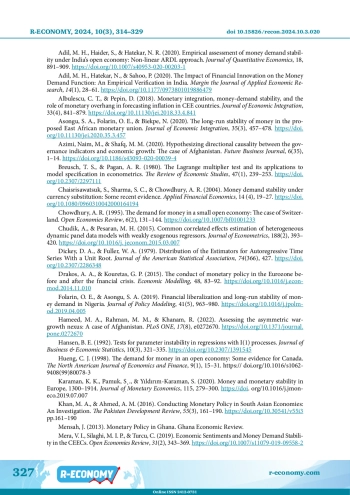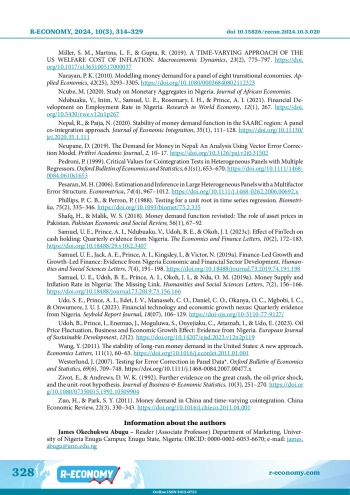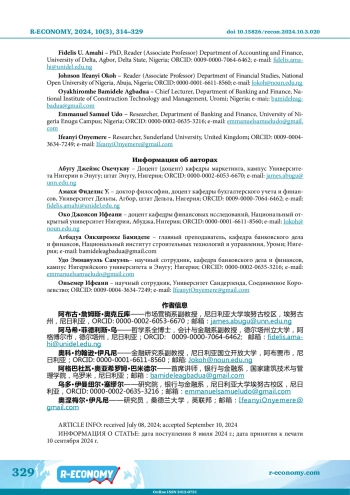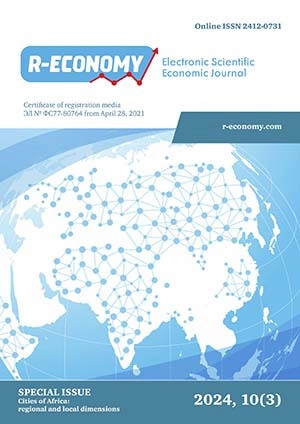Relevance: The stability of money demand is essential for effective monetary policy, especially in Sub-Saharan African (SSA) countries that face various economic challenges. These challenges include volatile exchange rates, fluctuating foreign interest rates, and high inflation, all of which can disrupt money demand stability. Understanding how these dynamics interact with different income levels-upper middle, lower middle, and low-is crucial for developing effective regional monetary policies and achieving economic stability. Research Objective: This study aims to evaluate the stability of money demand across different income levels-upper middle, lower middle, and low-in SSA. By applying the cash-in-advance theory, the study seeks to provide insights and actionable policy recommendations on the influence of key economic variables. Data and Method. This study employs the cross-sectional augmented autoregressive distributed lag (CS-ARDL) model to analyze both the short- and longrun influences of real exchange rates, foreign interest rates, real GDP, and inflation on money demand. By doing so, it aims to provide a nuanced understanding of money demand stability, capturing variations often overlooked in existing research. The analysis uses data from the World Bank Indicators and the International Monetary Fund (IMF), allowing for a detailed examination of money demand stability across various income levels in the region. Results. The findings reveal a positive and significant relationship between the real exchange rate, foreign interest rates, real gross domestic product, and real monetary aggregates. However, inflation has a contractionary effect on the real monetary aggregate, destabilizing money demand. Money demand stability is observed in upper-middle and low-income countries, while lower-middle-income countries exhibit variability, indicating differing levels of economic resilience across income categories. Conclusion. The study recommends adopting unified monetary policies and a single currency to enhance stability and stimulate economic growth in the region. Additionally, implementing inflation-targeting policies can further strengthen economic stability and promote sustainable development in SSA.
Идентификаторы и классификаторы
In the 21st century, as economic globalization advances and monetary policy frameworks evolve, understanding the dynamics of money demand in Sub-Saharan Africa (SSA) has gained critical importance for both scholars and policymakers. The region faces a variety of economic and developmental challenges, exacerbated by uncertain economic conditions that stifle both domestic and foreign investment. Volatility in money demand and exchange rates further complicates the development of effective monetary policies, managing balance of payments, and alleviating external debt pressures. Additionally, high inflation rates diminish purchasing power, drive up living costs, and can potentially lead to social unrest (Adil et al., 2018; Samuel et al., 2019a).
Список литературы
1. Adil M. H., Rajadhyaksha N. (2020). Evolution of monetary policy approaches: A case study of Indian economy. Journal of Public Affairs, 21(1). DOI: 10.1002/pa.2113 EDN: GLYHIE
2. Adil M. H., Haider S., Hatekar N. R. (2018). Revisiting money demand stability in India: Some post-reform evidence (1996-2016). Indian Economic Journal, 66(3-4),326-346. DOI: 10.1177/0019466220938930
3. Adil M. H., Haider S., Hatekar N. R. (2020). Empirical assessment of money demand stability under India’s open economy: Non-linear ARDL approach. Journal of Quantitative Economics, 18, 891-909. DOI: 10.1007/s40953-020-00203-1 EDN: MUWBXP
4. Adil M. H., Hatekar N., Sahoo P. (2020). The Impact of Financial Innovation on the Money Demand Function: An Empirical Verification in India. Margin the Journal of Applied Economic Research, 14(1), 28-61. DOI: 10.1177/0973801019886479 EDN: MEJQLE
5. Albulescu C. T., Pepin D. (2018). Monetary integration, money-demand stability, and the role of monetary overhang in forecasting inflation in CEE countries. Journal of Economic Integration, 33(4), 841-879. DOI: 10.11130/jei.2018.33.4.841
6. Asongu S. A., Folarin O. E., Biekpe N. (2020). The long-run stability of money in the proposed East African monetary union. Journal of Economic Integration, 35(3), 457-478. DOI: 10.11130/jei.2020.35.3.457 EDN: ORJAWF
7. Azimi Naim, M., Shafq M. M. (2020). Hypothesizing directional causality between the governance indicators and economic growth: The case of Afghanistan. Future Business Journal, 6(35), 1-14. DOI: 10.1186/s43093-020-00039-4 EDN: KEYMJL
8. Breusch T. S., Pagan A. R. (1980). The Lagrange multiplier test and its applications to model specification in econometrics. The Review of Economic Studies, 47(1), 239-253. DOI: 10.2307/2297111
9. Chaisrisawatsuk S., Sharma S. C., Chowdhury A. R. (2004). Money demand stability under currency substitution: Some recent evidence. Applied Financial Economics, 14 (4), 19-27. DOI: 10.1080/0960310042000164194 EDN: GJRFIT
10. Chowdhury A. R. (1995). The demand for money in a small open economy: The case of Switzerland. Open Economies Review, 6(2), 131-144. DOI: 10.1007/bf01001233
11. Chudik A., Pesaran M. H. (2015). Common correlated effects estimation of heterogeneous dynamic panel data models with weakly exogenous regressors. Journal of Econometrics, 188(2), 393-420. DOI: 10.1016/j.jeconom.2015.03.007
12. Dickey D. A., Fuller W. A. (1979). Distribution of the Estimators for Autoregressive Time Series With a Unit Root. Journal of the American Statistical Association, 74(366), 427. DOI: 10.2307/2286348
13. Drakos A. A., Kouretas G. P. (2015). The conduct of monetary policy in the Eurozone before and after the fnancial crisis. Economic Modelling, 48, 83-92. DOI: 10.1016/j.econmod.2014.11.010
14. Folarin O. E., Asongu S. A. (2019). Financial liberalization and long-run stability of money demand in Nigeria. Journal of Policy Modeling, 41(5), 963-980. DOI: 10.1016/j.jpolmod.2019.04.005
15. Hameed M. A., Rahman M. M., Khanam R. (2022). Assessing the asymmetric wargrowth nexus: A case of Afghanistan. PLoS ONE, 17(8), e0272670. DOI: 10.1371/journal.pone.0272670 EDN: YLNNWJ
16. Hansen B. E. (1992). Tests for parameter instability in regressions with I(1) processes. Journal of Business & Economic Statistics, 10(3), 321-335. DOI: 10.2307/1391545
17. Hueng C. J. (1998). The demand for money in an open economy: Some evidence for Canada. The North American Journal of Economics and Finance, 9(1), 15-31. DOI: 10.1016/s1062-9408(99)80078-3
18. Karaman K. K., Pamuk S¸., Yıldırım-Karaman S. (2020). Money and monetary stability in Europe, 1300-1914. Journal of Monetary Economics, 115, 279-300. DOI: 10.1016/j.jmoneco.2019.07.007 EDN: JLUUDK
19. Khan M. A., Ahmed A. M. (2016). Conducting Monetary Policy in South Asian Economies: An Investigation. The Pakistan Development Review, 55(3), 161-190. DOI: 10.30541/v55i3pp.161-190
20. Mensah J. (2013). Monetary Policy in Ghana. Ghana Economic Review.
21. Mera V. I., Silaghi M. I. P., Turcu C. (2019). Economic Sentiments and Money Demand Stability in the CEECs. Open Economies Review, 31(2), 343-369. DOI: 10.1007/s11079-019-09558-2 EDN: QYFUND
22. Miller S. M., Martins L. F., Gupta R. (2019). A TIME-VARYING APPROACH OF THE US WELFARE COST OF INFLATION. Macroeconomic Dynamics, 23(2), 775-797. DOI: 10.1017/s1365100517000037
23. Narayan P. K. (2010). Modelling money demand for a panel of eight transitional economies. Applied Economics, 42(25), 3293-3305. DOI: 10.1080/00036840802112323
24. Ncube M. (2020). Study on Monetary Aggregates in Nigeria. Journal of African Economies.
25. Ndubuaku V., Inim V., Samuel U. E., Rosemary I. H., Prince A. I. (2021). Financial Development on Employment Rate in Nigeria. Research in World Economy, 12(1), 267. DOI: 10.5430/rwe.v12n1p267 EDN: WPLCCI
26. Nepal R., Paija N. (2020). Stability of money demand function in the SAARC region: A panel co-integration approach. Journal of Economic Integration, 35(1), 111-128. DOI: 10.11130/jei.2020.35.1.111 EDN: NJCHUH
27. Neupane D. (2019). The Demand for Money in Nepal: An Analysis Using Vector Error Correction Model. Prithvi Academic Journal, 2, 10-17. DOI: 10.3126/paj.v2i0.31502
28. Pedroni P. (1999). Critical Values for Cointegration Tests in Heterogeneous Panels with Multiple Regressors. Oxford Bulletin of Economics and Statistics, 61(s1), 653-670. DOI: 10.1111/1468-0084.0610s1653
29. Pesaran M. H. (2006). Estimation and Inference in Large Heterogeneous Panels with a Multifactor Error Structure. Econometrica, 74(4), 967-1012. DOI: 10.1111/j.1468-0262.2006.00692.x
30. Phillips P. C. B., Perron P. (1988). Testing for a unit root in time series regression. Biometrika, 75(2), 335-346. DOI: 10.1093/biomet/75.2.335 EDN: ILNEET
31. Shafq H., Malik W. S. (2018). Money demand function revisited: The role of asset prices in Pakistan. Pakistan Economic and Social Review, 56(1), 67-92.
32. Samuel U. E., Prince A. I., Ndubuaku V., Udoh B. E., Okoh J. I. (2023c). Effect of FinTech on cash holding: Quarterly evidence from Nigeria. The Economics and Finance Letters, 10(2), 172-183. DOI: 10.18488/29.v10i2.3407
33. Samuel U. E., Jack A. E., Prince A. I., Kingsley I., Victor N. (2019a). Finance-Led Growth and Growth-Led Finance: Evidence from Nigeria Economic and Financial Sector Development. Humanities and Social Sciences Letters, 7(4), 191-198. DOI: 10.18488/journal.73.2019.74.191.198
34. Samuel U. E., Udoh B. E., Prince A. I., Okoh J. I., Ndu O. M. (2019a). Money Supply and Inflation Rate in Nigeria: The Missing Link. Humanities and Social Sciences Letters, 7(2), 156-166. DOI: 10.18488/journal.73.2019.73.156.166
35. Udo S. E., Prince A. I., Edet I. V., Manasseh C. O., Daniel C. O., Okanya O. C., Mgbobi I. C., Onwumere J. U. J. (2023). Financial technology and economic growth nexus: Quarterly evidence from Nigeria. Seybold Report Journal, 18(07), 106-129. https://doi-ojs.org/10-5110-77-9127.
36. Udoh B., Prince I., Enemuo J., Moguluwa S., Onyejiaku C., Attamah I., Udo E. (2023). Oil Price Fluctuation, Business and Economic Growth Effect: Evidence from Nigeria. European Journal of Sustainable Development, 12(2). DOI: 10.14207/ejsd.2023.v12n2p119 EDN: DUVHWH
37. Wang Y. (2011). The stability of long-run money demand in the United States: A new approach. Economics Letters, 111(1), 60-63. DOI: 10.1016/j.econlet.2011.01.001
38. Westerlund J. (2007). Testing for Error Correction in Panel Data*. Oxford Bulletin of Economics and Statistics, 69(6), 709-748. DOI: 10.1111/j.1468-0084.2007.00477.x
39. Zivot E., Andrews D. W. K. (1992). Further evidence on the great crash, the oil-price shock, and the unit-root hypothesis. Journal of Business & Economic Statistics, 10(3), 251-270. DOI: 10.1080/07350015.1992.10509904
40. Zuo,H., Park, S. Y. (2011). Money demand in China and time-varying cointegration. China Economic Review, 22(3), 330-343. DOI: 10.1016/j.chieco.2011.04.001
Выпуск
Другие статьи выпуска
Relevance. The study of inclusive economic growth remains highly relevant as the concept of growth continues to evolve. Measuring and analysing its determinants offers opportunities to foster inclusive growth at both regional and national levels. Research Objective. This study analyses inclusive economic growth in East Java’s districts and cities from 2018-2022 by comparing two measurement models: the Social Mobility Curve (SMC), which focuses on income distribution and economic growth, and the Poverty Equivalent Growth Rate (PEGR), which incorporates poverty, inequality, and unemployment. Data and Method. Using data from Statistics Indonesia (BPS), the National Labour Force Survey (SAKERNAS), and the National Socioeconomic Survey (SUSENAS) for 2018-2022, this study applies the SMC and PEGR models and conducts panel data regression to analyse inclusive growth and its determinants. Results. The findings reveal that economic growth in East Java lacks inclusivity. Income distribution inequality persists across districts and cities, as shown by the SMC results. The PEGR model also indicates ongoing challenges in reducing poverty and unemployment inclusively. Key factors such as the share of manufacturing in GRDP and employment opportunities significantly impact inclusive growth. Conclusions. Encouraging investment growth can create a favourable business climate across all districts/cities, supporting a more equitable contribution to GRDP. As employment opportunities play a significant role in inclusive growth, boosting employment through investment can improve access to education and healthcare, while addressing unemployment. To combat inequality and poverty, the government must refine its data collection on the poor to better target beneficiaries.
Relevance. External shocks can disrupt stable industrial development and technological modernization, especially in open single-industry regions that are highly vulnerable to global market fluctuations. The dominance of a single sector results in structural inertia, making it difficult for these regions to shift their economic trajectory. This path dependence amplifies the risks posed by economic turbulence, highlighting the need for changes in the economic structure and strategic guidelines for regional industrial policies. Objective. This study aims to describe the current, strategic, and future development paths for single-industry regions amid economic turbulence. It focuses on changes in the industrial profiles of metallurgical regions in Russia, including Lipetsk, Vologda, Murmansk, Sverdlovsk, Chelyabinsk, and Krasnoyarsk. Data and methods. The research uses publicly available statistics from 2008 to 2021, grounded in regional development theory. Methodologically, the study relies on coefficient analysis, positional-dynamic analysis, and assessment of technological connections between sectors. Results. The study has detected significant differences in regional adaptation: Lipetsk and Chelyabinsk are shifting towards low-tech sectors, Sverdlovsk maintains its metallurgical focus, Vologda is balancing metallurgy and a medium-high-tech chemical industry, while Murmansk and Krasnoyarsk are transforming with a focus on low-tech mineral extraction. Promising specializations include machine engineering in Sverdlovsk and Vologda, as well as machine engineering and electrical equipment production in Lipetsk and Chelyabinsk. However, we found discrepancies between the declared strategic goals and actual priorities in Lipetsk and Chelyabinsk. Conclusions. The findings offer valuable insights for policymakers and authorities, helping to update strategies for fostering the growth of promising industrial sectors.
Relevance. Local governments in both developed and developing countries act as a vital link between central governments and local communities. Central government funding transfers to local governments are often based on performance measures. In Ghana, the District Performance Assessment Tool (DPAT) has been utilized to evaluate local government performance since 2018, with a primary focus on improving service delivery to meet the needs of local residents. Research objective. This paper aims to analyze how the DPAT was conducted for the five selected local governments in the Central Region of Ghana from 2021 to 2022. Data and methods. The study employs a qualitative approach to the analysis of the primary data gathered from ten technical officers and 16 Assembly members, who served as key informants. A document review guide was also used to collect secondary data. Results. While the DPAT indicators aimed at assessing service delivery to communities, many were focused primarily on the internal operations of local governments. Although the DPAT represents an improvement over the District Development Facility’s Functional and Organizational Assessment Tool, the assessors did not interview Assembly members to verify the services delivered in the communities. Conclusions. The findings and methods of this study can inform analyses of local government performance in Ghana. It is recommended that DPAT assessors conduct field visits to interview Assembly members to enhance the assessment process. This study contributes to the understanding of financial resource allocation and service delivery in local governments.
Relevance. Libya has been struggling with fresh water shortages for much of its history. This issue started to be resolved only after significant underground water reserves were discovered in the southern part of the country in the late 1960s. From 1970 to 2010, the country became one of the world leaders in terms of water consumption per capita. Research objective. The study aims to evaluate compliance adopted and proposed solutions for developing the water supply system for urban settlements and agricultural enterprises in Libya, implemented during Muammar Gaddafi’s leadership, align with the canonical theories of Spatial Science. Data and method. Methodologically, the study relies on the principles of the isolated state theory and the central place theory. The transformation of the water supply structure in Libya studies within the evolutionary approach on using the example of agricultural projects and settlement projects in the Kufra region, as well as the “Great Man-Made River” project. Results. Each state farm in Libya represents a quasi “isolated state” which is the first stage in the development of the country’s water supply system. However, it only becomes a system in the proper sense at the second stage, with the emergence of private farms in settlements: central place systems with one (rarely two) levels of hierarchy arise “from” the rural areas. The transition to the third stage-the formation of a full-fledged central place system-was made possible by the “Great Man-Made River” project. Conclusions. The water supply systems for the population and economy of Libya in their current form are characterized by fairly high spatial stability. The government’s decision to merge the previously separate water supply systems of Al-Kufra - Sirt / Benghazi and Hasouna - Sahl Jefara through the “Great Man-Made River” project was quite reasonable. Equally prudent was the choice to maintain the Ghadames - Zwara - Zawia system as an isolated entity. However, the project to extend the water pipeline from Ajdabiya to Tobruk, which is currently less than 1% complete, should be discontinued. Instead, it would be more practical to revisit the previously rejected plan to supply freshwater to the cities along Libya’s eastern coast from the local underground sources.
Relevance. Africa presents a unique case: despite having the lowest urbanization levels in the world, it demonstrates the highest rates of urban population growth. Universities in large African cities play a key role in developing human capital by providing educational opportunities and training in digital skills necessary for participation in the digital economy. Objective. This article aims to assess the relationship between digital higher education, a key component of human capital, and economic development in African countries. It also explores the Digital Education Index and the factors influencing it in African cities and countries. We hypothesize that the composite Digital Education Index will reveal connections between economic development, urbanization, digital infrastructure, and digital education. Data and Methods. The study uses data from African cities and countries for 2019-2022, sourced from Trading Economics, the World Bank, International Monetary Fund, Free Apply, UNESCO, and the World Intellectual Property Organization. The methodology is based on an index approach, using measures of central tendency. The Digital Education Index is calculated through three sub-indices: technical accessibility of digital technologies, financial-economic accessibility of digital education, and population digital skills. Results. Digital education contributes to human capital development in Africa while reducing inequality and social vulnerability. However, progress in improving the Digital Education Index has been limited, as African universities face challenges such as restricted technology access and low living standards, which limit access to paid education. Conclusion. The study provides policy recommendations highlighting the importance of a comprehensive approach to addressing the challenges of digital education development in Africa.
Relevance. Urbanization is a crucial transformative process that plays a key role in achieving sustainable economic development in the global economy. An urbanized economy can serve as a vital structural mechanism to foster inclusive economic growth by generating employment, reducing income inequalities, and alleviating poverty. However, Sub-Saharan Africa (SSA) is characterized by a unique and slow urbanization process that sets it apart from other regions, despite steady economic growth in recent decades. Research Objective. This study aims to empirically assess the patterns and determinants of urbanization in SSA, focusing on the question of whether it is driven primarily by mere economic survival or by improvements in quality of life. Data and Methods. Based on Lee’s rural push-urban pull migration theory, the Common Correlated Effects Mean Group estimator was used to analyze data from 44 SSA countries between 1996 and 2022. Results. Access to basic amenities has a positive and significant impact on urbanization in Africa, although the effect was more modest for improved amenities. Additionally, the agricultural sector was found to hinder urbanization, while the manufacturing and services sectors promote it through structural transformation. Conclusion. The paper concludes that urbanization in SSA is driven by both the need for economic survival and the desire to improve quality of life. To enhance the region’s global competitiveness, it is crucial to invest in and develop critical infrastructure that supports the urbanization process.
In 2007, the world reached a pivotal moment in the ongoing process of urbanization, with the global urban population surpassing the rural population for the first time. Africa is the only continent where this process has not yet been completed. According to UN projections, it is expected to occur no earlier than the second third of the 21st century. Africa, however, is very diverse in this regard: in some countries, the majority of the population has long been urban, while in others, most of the population are still living in rural areas.
Статистика статьи
Статистика просмотров за 2025 год.
Издательство
- Издательство
- УрФУ
- Регион
- Россия, Екатеринбург
- Почтовый адрес
- 620002, Свердловская область, г. Екатеринбург, ул. Мира, д. 19
- Юр. адрес
- 620002, Свердловская область, г. Екатеринбург, ул. Мира, д. 19
- ФИО
- Кокшаров Виктор Анатольевич (Ректор)
- E-mail адрес
- rector@urfu.ru
- Контактный телефон
- +7 (343) 3754507
- Сайт
- https://urfu.ru/ru
